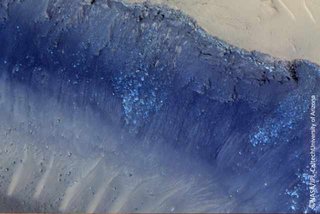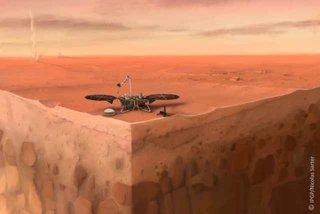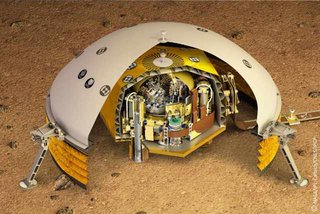Based on the analysis of marsquakes recorded by NASA’s InSight mission, the structure of Mars’s crust has now been determined in absolute numbers for the first time. Beneath the InSight landing site, the crust is either approximately 20 or 39 kilometres thick. That is the result of an international research team led by geophysicist Dr Brigitte Knapmeyer-Endrun at the University of Cologne’s Institute of Geology and Mineralogy and Dr Mark Panning at Jet Propulsion Laboratory, California Institute of Technology (Caltech). InSight stands for ‘Interior Exploration using Seismic Investigations, Geodesy and Heat Transport’. NASA’s lander, which landed on Mars on 26 November 2018, explores the crust, mantle and core of the red planet. The paper ‘Thickness and structure of the Martian crust from InSight seismic data’ will appear in Science on July 23.
In the past, only relative differences in the thickness of Mars’s could be estimated, and additional assumptions were required to obtain absolute thicknesses. The resulting absolute values thus showed large scatter, depending on which assumptions were made. Seismology now replaces these assumptions with a direct measurement at the landing site, and thus calibrates the crustal thickness for the entire planet. This independent data point also allows estimating the density of the crust.
‘What seismology can measure are mainly velocity contrasts. These are differences in the propagation velocity of seismic waves in different materials,’ said Knapmeyer-Endrun, lead author of the paper. ‘Very similar to optics, we can observe phenomena like reflection and refraction. Regarding the crust, we also benefit from the fact that crust and mantle are made of different rocks, with a strong velocity jump between them.’ Based on these jumps, the crust’s structure can be determined very precisely.
The data show that at the InSight landing site, the top layer is about 8 (+/-2) kilometres thick. Below that, another layer follows to about 20 (+/-5) kilometres. ‘It is possible that the mantle starts under this layer, which would indicate a surprisingly thin crust, even compared to the continental crust on Earth. Beneath Cologne, for example, the Earth's crust is about 30 kilometres thick,’ Knapmeyer-Endrun explained. Possibly, however, there is a third crustal layer on Mars, which would make the Martian crust under the landing site about 39 (+/-8) kilometres thick. That would be more consistent with previous findings, but the signal from this layer is not essential to match existing data. ‘In both cases, however, we can rule out the possibility that the entire crust is made of the same material known from surface measurements and from Martian meteorites,’ the geophysicist said. ‘Rather, the data suggest that the uppermost layer is composed of an unexpectedly porous rock. Also, there could be other rock types at greater depths than the basalts seen at the surface.’
The single, independent measurement of crustal thickness at the InSight landing site is sufficient to map the crust across the entire planet. Measurements from satellites orbiting Mars provide a very clear picture of the planet’s gravity field, allowing the scientists to compare relative differences in crustal thickness to the measurement taken at the landing site. The combination of these data provides an accurate map.
The crustal thickness of Mars is particularly interesting because the crust formed at an early formation stage from the remnants of a molten mantle. Thus, data on its present-day structure can also provide information on how Mars evolved. In addition, a more precise understanding of the evolution of Mars helps to decipher how early differentiation processes unfolded in the solar system and why Mars, Earth, and other planets are so different today.
Jet Propulsion Laboratory (JPL) manages InSight for NASA’s Science Mission Directorate. InSight is part of NASA’s Discovery Program, managed by the agency’s Marshall Space Flight Center in Huntsville, Alabama. Lockheed Martin Space in Denver built the InSight spacecraft, including its cruise stage and lander, and supports spacecraft operations for the mission.
A number of European partners, including France’s Centre National d’Études Spatiales (CNES) and the German Aerospace Center (DLR), are supporting the InSight mission. CNES provided the Seismic Experiment for Interior Structure (SEIS) instrument to NASA, with the principal investigator at IPGP (Institut de Physique du Globe de Paris). Significant contributions for SEIS came from IPGP; the Max Planck Institute for Solar System Research (MPS) in Germany; the Swiss Federal Institute of Technology (ETH Zurich) in Switzerland; Imperial College London and Oxford University in the United Kingdom; and JPL. DLR provided the Heat Flow and Physical Properties Package (HP3) instrument, with significant contributions from the Space Research Center (CBK) of the Polish Academy of Sciences and Astronika in Poland. Spain’s Centro de Astrobiología (CAB) supplied the temperature and wind sensors.
Media Contact:
Dr Brigitte Knapmeyer-Endrun
Institute of Geology and Mineralogy
+49 0221 470 7130
brigitte.knapmeyer-endrununi-koeln.de
Press and Communications Team:
Jan Voelkel
+49 221 470 2356
j.voelkelverw.uni-koeln.de
Publication:
Further information as well as a copy of the article is available from the science press package team of the American Society for the Advancement of Science: +1-202-326-6777 / scipakaaas.org / http://www.eurekalert.org/jrnls/sci/


